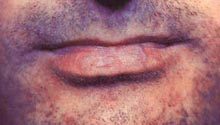Lichen Planus: Symptoms, Causes
and Treatment

Lichen Planus affecting lip.
|
Lichen planus is a relatively common skin or oral disease that comes in episodes lasting months to years. The onset may be gradual or quick, but its cause, like many skin diseases, is unknown. It appears to be a reaction in response to more than one provoking factor. Theories include stress, genetics, infective (viral hepatitis C) and immunologic (autoimmune). There are also drugs that produce lichen planus-like allergic reactions to high blood pressure, heart disease, and arthritis medications. There is an inherited form also which is often more severe and can have a protracted course.
Symptoms include:
- Lichen planus of the skin appears as shiny, purplish, flat-topped, raised spots, usually 25-50 mm across at first. Later they get bigger (or several spots may form together), becoming brown with white lines or scales across their surface.
- Lichen planus of the mouth most commonly affects the inside of the cheeks, gums and tongue. White steaks may appear on the inside lining of the mouth, with blotches on the tongue.
- Itching is intense.
- Finger-nails may break and be destroyed.
- If a scratch is made, spots may form along the line of the scratch.
- The scalp may be affected with a patchy loss of hair, which is occasionally permanent.
There is no known cure for skin lichen planus, but treatment is often effective in relieving itching and improving the appearance of the rash until it goes away.
Oral lichen planus is more difficult to treat and typically lasts longer than skin lichen planus.
|